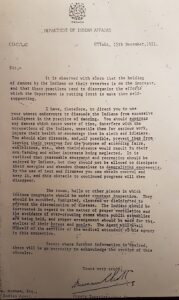100th anniversary of letter to Indian Agents regarding dancing

By Sarah St. Louis
History has a way of repeating itself. We’ve seen this time and time again as the years roll on. Even pandemics, as treacherous and unpredictable as the coronavirus disease 2019 (COVID-19) has been this past year, have played an important part in the world’s history. In efforts to limit spread and transmissions, the current pandemic has had an isolating effect that has pushed Anishinabek to adapt once again— to evolve our knowledge, ceremony, culture and connections using technology.
We all have been working towards keeping our family, friends and communities safe. We have experienced the cancellation and postponement of many events and gatherings in our Nations, as well as mainstream, and a shift to online delivery of programs and said events. History repeats itself. Anishinabek culture and ceremony has a long history of being suppressed and discouraged, for safety and sanitary conditions.
Duncan Campbell Scott might sound like a familiar name— or maybe not. For those unfamiliar with the name, Scott was an Indian Agent who served as deputy superintendent of the Department of Indian Affairs from 1913 to 1932. He supported the development of the Canadian Government’s colonial legislation, the Indian Act. He was also responsible for the oversight of the operations of the Residential School System, where he implemented compulsory school attendance for all First Nations children less than 15 years of age. He has a number of notable letters to Indian Agents in the Bureau of Indian Affairs that communicate Canada’s ‘Indian Problem’:
“I want to get rid of the Indian problem. I do not think as a matter of fact, that the country ought to continuously protect a class of people who are able to stand alone… Our objective is to continue until there is not a single Indian in Canada that has not been absorbed into the body politic and there is no Indian question, and no Indian Department, that is the whole object of this Bill.”
This year marks the 100th year anniversary of a letter Scott circulated on December 15, 1921, to Indian Agents that states:
“It is observed with alarm that the holding of dances by the Indians on their reserves is on the increase, and that these practices tend to disorganize the efforts which the Department is putting forth to make them self-supporting.
I have, therefore, to direct you to use your utmost endeavours to dissuade the Indians from excessive indulgence in the practice of dancing. You should suppress any dances which cause waste of time, interfere with the occupations of the Indians, unsettle them for serious work, injure their health or encourage them in sloth and idleness. You should also dissuade, and, if possible, prevent them from leaving their reserves for the purpose of attending fairs, exhibitions, etc., when their absence would result in their own farming and other interests being neglected. It is realized that reasonable enjoyment and recreation should be enjoyed by Indians, but they should not be allowed to dissipate their energies and abandon themselves to demoralizing amusements. By the use of tact and firmness you can obtain control and keep it, and this obstacle to continued progress will then disappear.
The rooms, halls or other places in which Indians congregate should be under constant inspection. They should be scrubbed, fumigated, cleansed or disinfected to prevent the dissemination of disease. The Indians should be instructed in regard to the matter of proper ventilation and the avoidance of over-crowding rooms where public assemblies are being held, and proper arrangement should be made for the shelter of their horses and ponies. The Agent will avail himself of the services of the medical attendant of his agency in this connection.
Except where further information is desired, there will be no necessity to acknowledge the receipt of this circular.”
Reading historical documents like these letters can be difficult. This letter in particular strikes a chord given the parallels we can draw with our current pandemic climate. Our culture and traditions are being discouraged once again, this time in the form of not being able to gather in person, and from a different adversary. An invisible one that may prove even harder to overcome.
As always, Anishinabek are resilient. Through great strength and perseverance, we are here and we are using this time and technology to connect digitally. As we work towards gathering in-person safely again, we take this time to learn together and practise individually or with close family circles. It has been and continues to be a trying time for our Elders, youth, women, families and communities, but we keep moving forward— adapting, learning, and practicing. Western science will play its part, but our people see the real value in ceremony, culture and connections past and present as an important part of the solution.
This coming December, remember Scott’s words and the resiliency of Anishinabek. Safely celebrate our traditions, culture and ceremony. History repeats itself. Through this pandemic, we will continue to learn, strengthen our knowledge, and know that we will soon gather and dance again – as we always have.


